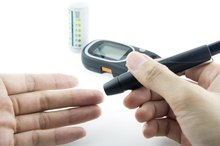Autoimmune Diseases That Cause Peripheral Neuropathy
Peripheral neuropathy occurs when the nerves in the arms and legs are damaged due to injury or disease. The condition causes a wide range of symptoms such as numbness or tingling, weak muscles, loss of sensations and insensitivity to temperature. Autoimmune diseases result from a malfunction of the body’s immune system in which the immune cells attack healthy cells. Autoimmune diseases affect approximately 23.5 million Americans, according to the American Autoimmune Related Diseases Association.
If you are experiencing serious medical symptoms, seek emergency treatment immediately.
Multiple Sclerosis
Multiple sclerosis, a chronic and often debilitating disease, occurs when the immune system attacks the myelin, the fatty substance that surrounds and protects the nerves. As myelin becomes damaged, scar tissue forms and interferes with the signals between the nerves, the spinal cord and the brain. The National Multiple Sclerosis Society reports that approximately 2.1 million people worldwide suffer from multiple sclerosis 2. When the peripheral nerves in the extremities become damaged, the patient experiences numbness and tingling in the arms and legs, weakness or paralysis of muscles in the arms or legs, tremors and a loss of balance.
- Multiple sclerosis, a chronic and often debilitating disease, occurs when the immune system attacks the myelin, the fatty substance that surrounds and protects the nerves.
- As myelin becomes damaged, scar tissue forms and interferes with the signals between the nerves, the spinal cord and the brain.
Type 1 Diabetes
Causes of Necrosis in Diabetes
Learn More
Diabetes, including both type 1 and type 2, is the number one cause of peripheral neuropathy in the United States, according to the National Institute of Neurologic Disorders and Stroke 1. The excess glucose in the blood damages the peripheral causing a loss of feeling in the toes, feet, legs, hands and arms. Addition symptoms include:
- numbness
- tingling
- burning sensation
- insensitivity to pain
- cramps
- sharp pain
- a loss of balance
Rheumatoid Arthritis
Rheumatoid arthritis, which according to the Arthritis Foundation affects 1.3 million Americans, occurs when the immune system attacks the cells of the synovium, the lining of the membrane surrounding the joints. This causes inflammation in the joints which over time can affect the cartilage and the bone. The swelling, stiffness and pain in the joints can lead to damage to the peripheral nerves, especially the sensory nerves.
Related Articles
References
- National Institute of Neurologic Disorders and Stroke: Peripheral Neuropathy
- National Multiple Sclerosis Society: Who Gets MS?
- Koop LK, Tadi P. Neuroanatomy, Sensory Nerves. [Updated 2019 Apr 7]. In: StatPearls [Internet]. Treasure Island (FL): StatPearls Publishing; 2019 Jan-.
- Institute of Medicine (US) Committee on Multiple Sclerosis: Current Status and Strategies for the Future; Joy JE, Johnston RB Jr., editors. Multiple Sclerosis: Current Status and Strategies for the Future. Washington (DC): National Academies Press (US); 2001. 3, Characteristics and Management of Major Symptoms.
- Hammi C, Yeung B. Neuropathy. [Updated 2019 Jun 4]. In: StatPearls [IntAvailable from:
- Colloca L, Ludman T, Bouhassira D, et al. Neuropathic pain. Nat Rev Dis Primers. 2017;3:17002. Published 2017 Feb 16. doi:10.1038/nrdp.2017.2
- Lima MA, Maranhão-filho P. What is the essential neurological examination?. Arq Neuropsiquiatr. 2012;70(12):939-41. doi:10.1590/s0004-282x2012001200007
- Marchettini P, Lacerenza M, Mauri E, Marangoni C. Painful peripheral neuropathies. Curr Neuropharmacol. 2006;4(3):175–181. doi:10.2174/157015906778019536
- Sommer C, Geber C, Young P, Forst R, Birklein F, Schoser B. Polyneuropathies. Dtsch Arztebl Int. 2018;115(6):83–90. doi:10.3238/arztebl.2018.083
- Koop LK, Tadi P. Neuroanatomy, Sensory Nerves. [Updated 2019 Apr 7]. In: StatPearls [Internet]. Treasure Island (FL): StatPearls Publishing; 2019 Jan-.
- McCorry LK. Physiology of the autonomic nervous system. Am J Pharm Educ. 2007;71(4):78. doi:10.5688/aj710478
- Tracy JA, Dyck PJ. The spectrum of diabetic neuropathies. Phys Med Rehabil Clin N Am. 2008;19(1):1–v. doi:10.1016/j.pmr.2007.10.010
- Ekabe CJ, Kehbila J, Abanda MH, Kadia BM, Sama CB, Monekosso GL. Vitamin B12 deficiency neuropathy; a rare diagnosis in young adults: a case report. BMC Res Notes. 2017 Jan 28;10(1):72. doi: 10.1186/s13104-017-2393-3
- Dimachkie MM, Barohn RJ. Guillain-Barré syndrome and variants. Neurol Clin. 2013;31(2):491–510. doi:10.1016/j.ncl.2013.01.005
- Menorca RM, Fussell TS, Elfar JC. Nerve physiology: mechanisms of injury and recovery. Hand Clin. 2013;29(3):317–330. doi:10.1016/j.hcl.2013.04.002
- Aroori S, Spence RA. Carpal tunnel syndrome. Ulster Med J. 2008;77(1):6–17. PMID: 18269111
- Cojocaru IM, Cojocaru M, Silosi I, Vrabie CD. Peripheral nervous system manifestations in systemic autoimmune diseases. Maedica (Buchar). 2014 Sep;9(3):289-94.
- Misra UK, Kalita J, Nair PP. Diagnostic approach to peripheral neuropathy. Ann Indian Acad Neurol. 2008;11(2):89–97. doi:10.4103/0972-2327.41875
- Jensen TS, Finnerup NB. Allodynia and hyperalgesia in neuropathic pain: clinical manifestations and mechanisms. Lancet Neurol. 2014;13(9):924-35. doi:10.1016/S1474-4422(14)70102-4
- Aman JE, Elangovan N, Yeh IL, Konczak J. The effectiveness of proprioceptive training for improving motor function: a systematic review. Front Hum Neurosci. 2015;8:1075. Published 2015 Jan 28. doi:10.3389/fnhum.2014.01075
- Desai J, Swash M. Fasciculations: what do we know of their significance?. J Neurol Sci. 1997;152 Suppl 1:S43-8. doi:10.1016/s0022-510x(97)00243-8
- Sommer C, Geber C, Young P, Forst R, Birklein F, Schoser B. Polyneuropathies. Dtsch Arztebl Int. 2018 Feb 9;115(6):83-90. doi: 10.3238/arztebl.2018.083.
- Wells R, Tonkin A. Clinical approach to autonomic dysfunction. Intern Med J. 2016;46(10):1134-1139. doi:10.1111/imj.13216
- Chopra K, Tiwari V. Alcoholic neuropathy: possible mechanisms and future treatment possibilities. Br J Clin Pharmacol. 2012;73(3):348–362. doi:10.1111/j.1365-2125.2011.04111.x
- Hammond N, Wang Y, Dimachkie MM, Barohn RJ. Nutritional neuropathies. Neurol Clin. 2013;31(2):477–489. doi:10.1016/j.ncl.2013.02.002
- Peltier AC, Russell JW. Recent advances in drug-induced neuropathies. Curr Opin Neurol. 2002;15(5):633-8. doi:10.1097/00019052-200210000-00015
- Crook L, Liu PI, Gadsden RH, Turner RE. Erythrocyte sedimentation, viscosity, and plasma proteins in disease detection. Ann Clin Lab Sci. 1980;10(5):368-76. PMID: 7425532
- Miller LJ, Saporta AS, Sottile SL, Siskind CE, Feely SM, Shy ME. Strategy for genetic testing in Charcot-Marie-disease. Acta Myol. 2011;30(2):109–116. PMID: 22106713
- Chung T, Prasad K, Lloyd TE. Peripheral neuropathy: clinical and electrophysiological considerations. Neuroimaging Clin N Am. 2014;24(1):49–65. doi:10.1016/j.nic.2013.03.023
- Weis J, Brandner S, Lammens M, Sommer C, Vallat JM. Processing of nerve biopsies: a practical guide for neuropathologists. Clin Neuropathol. 2012;31(1):7–23. doi:10.5414/np300468
- Ziemssen T, Siepmann T. The Investigation of the Cardiovascular and Sudomotor Autonomic Nervous System-A Review. Front Neurol. 2019;10:53. Published 2019 Feb 12. doi:10.3389/fneur.2019.00053
- Khan N, Smith MT. Multiple sclerosis-induced neuropathic pain: pharmacological management and pathophysiological insights from rodent EAE models. Inflammopharmacology. 2014;22(1):1–22. doi:10.1007/s10787-013-0195-3
- Institute of Medicine (US) Committee on Multiple Sclerosis: Current Status and Strategies for the Future; Joy JE, Johnston RB Jr., editors. Multiple Sclerosis: Current Status and Strategies for the Future. Washington (DC): National Academies Press (US); 2001. 3, Characteristics and Management of Major Symptoms.
- Chandra A, Stone CR, Du X, et al. The cerebral circulation and cerebrovascular disease III: Stroke. Brain Circ. 2017;3(2):66–77. doi:10.4103/bc.bc_12_17
- Bansal V, Kalita J, Misra UK. Diabetic neuropathy. Postgrad Med J. 2006;82(964):95–100. doi:10.1136/pgmj.2005.036137
- Staff NP, Windebank AJ. Peripheral neuropathy due to vitamin deficiency, toxins, and medications. Continuum (Minneap Minn). 2014;20(5 Peripheral Nervous System Disorders):1293–1306. doi:10.1212/01.CON.0000455880.06675.5a
- Meena AK, Khadilkar SV, Murthy JM. Treatment guidelines for Guillain-Barré Syndrome. Ann Indian Acad Neurol. 2011;14(Suppl 1):S73–S81. doi:10.4103/0972-2327.83087
- Hammi C, Yeung B. Neuropathy. [Updated 2019 Jun 4]. In: StatPearls [Int
- Przewlocki R, Przewlocka B. Opioids in neuropathic pain. Curr Pharm Des. 2005;11(23):3013-25. doi:10.2174/1381612054865055
- Juster-Switlyk K, Smith AG. Updates in diabetic peripheral neuropathy. F1000Res. 2016;5:F1000 Faculty Rev-738. Published 2016 Apr 25. doi:10.12688/f1000research.7898.1
- Cioroiu C, Weimer LH. Update on Chemotherapy-Induced Peripheral Neuropathy. Curr Neurol Neurosci Rep. 2017 Jun;17(6):47. doi: 10.1007/s11910-017-0757-7.
- Dimitrova A, Murchison C, Oken B. Acupuncture for the Treatment of Peripheral Neuropathy: A Systematic Review and Meta-Analysis. J Altern Complement Med. 2017 Mar 1;23(3):164-79. doi: 10.1089/acm.2016.0155
- Watson JC, Dyck PJ. Peripheral Neuropathy: A Practical Approach to Diagnosis and Symptom Management. Mayo Clin Proc. 2015 Jul;90(7):940-51. doi: 10.1016/j.mayocp.2015.05.004
Writer Bio
Stephanie Chandler is a freelance writer whose master's degree in biomedical science and over 15 years experience in the scientific and pharmaceutical professions provide her with the knowledge to contribute to health topics. Chandler has been writing for corporations and small businesses since 1991. In addition to writing scientific papers and procedures, her articles are published on Overstock.com and other websites.








